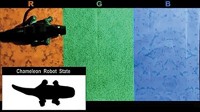Advertisement
Grab your lab coat. Let's get started
Welcome!
Welcome!
Create an account below to get 6 C&EN articles per month, receive newsletters and more - all free.
It seems this is your first time logging in online. Please enter the following information to continue.
As an ACS member you automatically get access to this site. All we need is few more details to create your reading experience.
Not you? Sign in with a different account.
Not you? Sign in with a different account.
ERROR 1
ERROR 1
ERROR 2
ERROR 2
ERROR 2
ERROR 2
ERROR 2
Password and Confirm password must match.
If you have an ACS member number, please enter it here so we can link this account to your membership. (optional)
ERROR 2
ACS values your privacy. By submitting your information, you are gaining access to C&EN and subscribing to our weekly newsletter. We use the information you provide to make your reading experience better, and we will never sell your data to third party members.
Photonics
Nanolaser changes color when stretched
The sensitive, tunable device is made of gold nanoparticles, a rubbery polymer, and a liquid dye
by Prachi Patel, special to C&EN
July 2, 2018

Inspired by a chameleon’s prowess, researchers have made a tiny elastic laser that changes color as it is stretched and released (Nano Lett. 2018, DOI: 10.1021/acs.nanolett.8b01774). The tunable nanolaser system could be used in flexible displays, wearable sensors, and lab-on-a-chip devices.
Chameleon skin has a layer of cells containing guanine nanocrystals. When the lizard tenses or relaxes its skin, the space between the crystals changes, altering the color of reflected light. In the quest to make compact light sources with tunable colors, some researchers have tried to emulate this mechanism.
One design involves embedding regular arrays of semiconductor nanostructures inside a rubbery material. In these nanolasers, light shined on the devices bounces around between the nanostructures, gets amplified, and emerges as a laser beam of a defined wavelength. That color changes when the material is stretched, changing the spacing of the array.
By adding some twists to that concept, Teri W. Odom, George C. Schatz, and their colleagues at Northwestern University have made a tunable nanolaser that is 10 times as sensitive as previous stretchable nanolasers and has the potential to give a wider range of colors.
First, they deposited an array of cylindrical, 260-nm-wide gold nanoparticles on a polydimethylsiloxane sheet. They surrounded the nanoparticles with a liquid gain material, a dye solution that amplifies light to achieve lasing. In previous work, Odom and colleagues had made a tunable nanolaser with a liquid gain material, but to change the nanolaser’s color, they had to switch out the dye solution.
In this new design, stretching does the trick instead. When activated with an external light source, the nanolaser emits near-infrared light at around 870 nm. The wavelength increases, or shifts farther into the infrared, when the device is stretched and goes back to the original wavelength when released.
“A liquid gain medium is perfect for a stretchable device,” Odom says. “When you stretch the substrate, the liquid follows it perfectly so there are always molecules to amplify light for lasing.”
The other novelty of the device is that it harnesses plasmons—collective oscillations of electrons—that exist on the surface of gold nanoparticles. “The plasmonic nanoparticles act like little antennas that concentrate incoming light into electromagnetic fields right around their surface,” Odom says.
So the surfaces become nanoscopic hotspots for lasing, and the tiniest change in the spacing between the nanoparticles causes a measurable color shift, making the device very sensitive. It gives slightly more wavelength change with only one-tenth of the stretching required for earlier similar laser designs.
Plus, tweaking both the type of dye and the nanoparticle spacing could give a wide range of emitted laser light colors, Odom says. The researchers now plan to make a device with a mixed nanoparticle array of different plasmonic materials, along with gold. Silver and aluminum nanoparticles, for instance, emit light in ultraviolet and visible wavelengths. “Side by side on the same substrate, you can imagine getting different [visible] lasing colors,” Odom says.
Advertisement
The combination of changeable liquid material and the plasmon resonance gives a robust, high-performance, and compact laser with wide-range tunability, says Ren-Min Ma, a physicist at Peking University. “It is a significant step towards the implementation of functional nanolasers.”




Join the conversation
Contact the reporter
Submit a Letter to the Editor for publication
Engage with us on Twitter